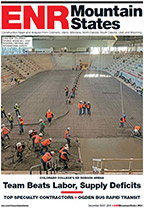Early Involvement
Within the past five years, the timing on specialty contractor involvement on projects has steadily moved forward, with firms brought into jobs much earlier than before. Brandt's Moore notes that an increase in early-contractor-involvement opportunities has allowed the firm to increase its market share.
Getting involved earlier "gives us an advantage, an opportunity to get in and work out some of the details that we would have run into typically later in the project and then trying to figure out what to do at that point," says Keith Giddens, director of virtual design and construction at wall and ceiling contractor Baker Triangle. "We're able to clear up some of the questions early in the process."
Giddens says Baker, which recently launched a prefabrication operation, was called in on one project "where the drawings weren't even at 50% ... to help them out with details and figure out how to do things." He adds, "I think [owners are] starting to figure out that if they get the players in there who know the most efficient way to build, it helps them with the whole process."
Baker Triangle reports regional revenue rising about $5 million over the previous year. That growth has "a lot to do with the technology we're using these days," Giddens says. "We're heavily into [building information modeling] so I think that really helps us improve our margins on these jobs."
BIM, early collaboration and the use of tools such as robotic total stations, which are still relatively new to the wall and ceiling market, are helping the firm stay ahead, Giddens says. Some of its recent projects include the Perot Museum of Nature and Science in Dallas and the Tobin Center for the Performing Arts in San Antonio.
"Everything is really exploding now, so there's a lot of work out there. It's like everywhere you drive around here you run into a couple of tower cranes," Giddens says. "I think it's going to stay fairly strong for the next couple of years at least. There is a lot of work out there right now, and there's a lot that we're hearing about that's coming up."
Work Force Conundrum
The consensus among specialty contractors is that the region's entire construction sector will continue to face a shortage of skilled and qualified craft workers.
"It will continue to be a challenge going forward to grow our work force and the skill level to meet the market needs," says TD's Kotubey. "We're very conscious about not overcommitting to our customer. There have been a couple cases where we've had to say no just because we don't have the right teams to go out and build a project. We have to manage our backlog with our execution capacity because one failure can really ruin your reputation."









Post a comment to this article
Report Abusive Comment